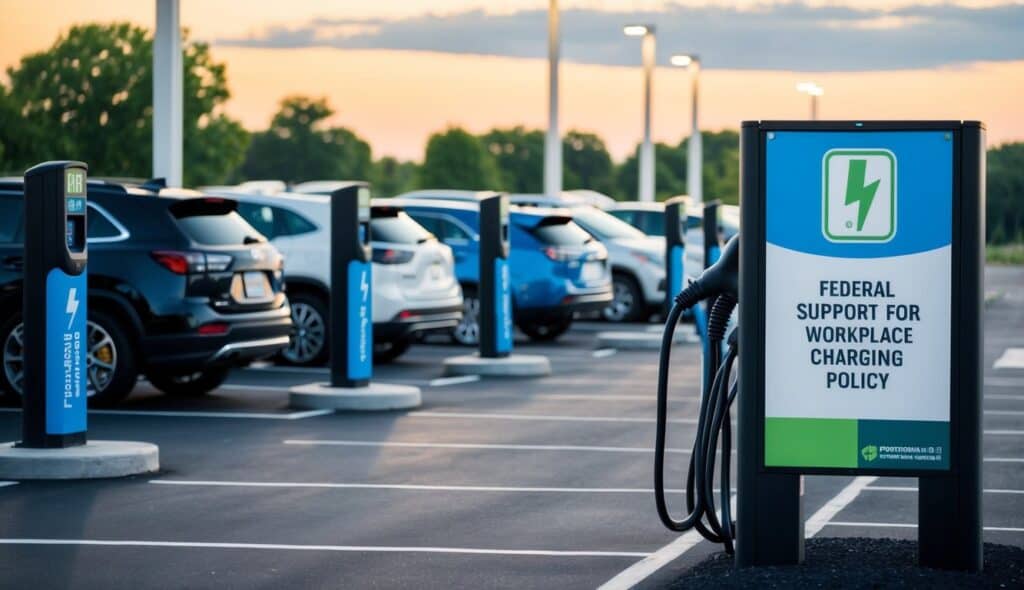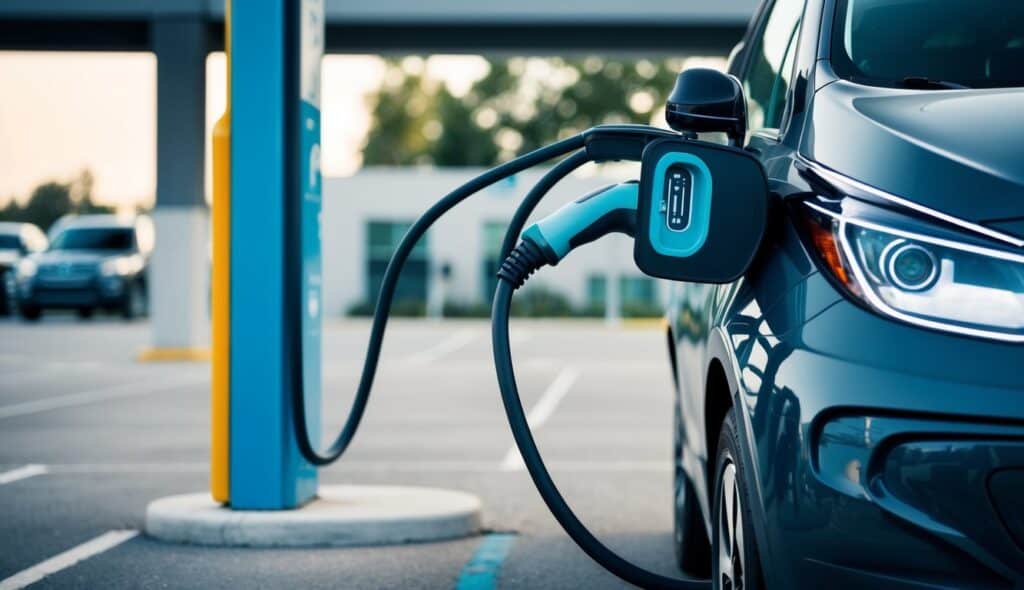Workplace electric vehicle charging policies are gaining traction across the United States. Many employers now offer charging stations as a perk for employees who drive electric cars. This trend aligns with broader efforts to reduce carbon emissions and promote sustainable transportation.
The U.S. government has taken steps to support workplace charging through initiatives like the Federal Workplace Charging Program. This program provides guidance to federal agencies on setting up charging stations for employees’ personal electric vehicles. It aims to make driving electric more convenient and affordable for federal workers.
Private companies are also embracing workplace charging policies. They see it as a way to attract and keep talented employees who care about the environment. Some businesses partner with charging network providers to install and manage the stations. As electric vehicle adoption grows, workplace charging is likely to become more common across the USA.
Understanding the Basics of EV Charging
Electric vehicle charging involves different station types and ways to measure electricity use. These elements are key for setting up workplace charging programs.

Types of Electric Vehicle Charging Stations
EV charging stations come in three main types. Level 1 chargers use a standard 120-volt outlet and add about 4-5 miles of range per hour. They’re the slowest option but easy to install.
Level 2 chargers use 240-volt power and can add 25-30 miles of range per hour. These are common for home and workplace charging.
DC fast chargers are the quickest option. They can add 60-80 miles of range in just 20 minutes. But they’re more expensive to install and use.
Workplaces often choose Level 2 chargers as a good balance of speed and cost.
Measuring Electricity for EV Charging
EV charging uses kilowatt-hours (kWh) to measure electricity. One kWh can power an EV for about 3-4 miles.
For cost comparison, the U.S. Department of Energy uses “gasoline gallon equivalents” (GGE). This shows how much electricity gives the same energy as a gallon of gas.
EV charging stations track electricity use. This helps set fair prices for workplace charging. It also lets employers see how much power their EV program uses.
Some chargers show real-time data on power use and charging speed. This helps EV drivers plan their charging time.
Federal Initiatives and Support
The US government has taken major steps to promote workplace EV charging. Federal agencies are working to expand charging access and provide funding and guidance for employers.
Biden-Harris Administration’s Role
The Biden-Harris Administration has made EV charging a key priority. In 2021, they announced a goal of building 500,000 public chargers by 2030. The Bipartisan Infrastructure Law includes $7.5 billion to help reach this target.
The administration created new standards for chargers. These ensure reliability and accessibility. They also require chargers to be made in America.
Grants totaling $623 million were awarded in 2023. These will help build out charging networks across the country. The funds aim to create jobs and expand charging access.
Department of Energy Programs
The Department of Energy (DOE) offers resources to support workplace charging. They created a Federal Workplace Charging Program Guide. This helps agencies develop policies for charging at their facilities.
The guide covers key topics like:
- Fee collection
- Charger installation
- Employee access
DOE also provides technical assistance. They help employers plan and implement charging programs. This includes site assessments and cost estimates.
Joint Office of Energy and Transportation
The DOE and Department of Transportation formed this office in 2021. It coordinates efforts to build out EV charging infrastructure.
The office oversees the National Electric Vehicle Infrastructure (NEVI) program. NEVI provides $5 billion to states for charging networks along highways.
They offer tools and resources for charging projects. This includes mapping tools to plan charger locations. The office also shares best practices from successful programs.
Workplace Charging Policy Development
Creating clear policies for electric vehicle charging at work is key. This includes setting rules for access and deciding on fees.

Creating EV Charging Access Policies
Workplace charging policies should define who can use the charging stations. Many companies allow all employees to charge their personal electric vehicles. Some may limit access to certain groups or departments.
Policies often set time limits for charging to ensure fair use. A common rule is a 4-hour limit during work hours. This lets more employees use the chargers each day.
Safety rules are also important. Policies should require proper use of charging equipment. They may ban extension cords or other unsafe practices.
Fee Structures for EV Charging
Companies can choose to offer free charging or charge a fee. Free charging is a nice perk, but can lead to overuse.
Pay-per-use is a common fee structure. Employees pay for the electricity they use. This can be billed by kWh or by time spent charging.
Some workplaces use a flat monthly fee for unlimited charging. This is simple to manage but may not reflect actual usage.
Fees can be collected through payroll deduction or a separate payment system. The money often goes back into running the charging program.
Infrastructure Implementation
Implementing workplace EV charging infrastructure requires careful planning and execution. Key steps include selecting optimal locations, designing effective installations, and managing costs.
Selecting Site Locations for EV Chargers
Choosing the right spots for EV chargers is crucial. Prime locations include:
- Parking areas near building entrances
- Spaces close to electrical rooms or panels
- Well-lit, visible areas for safety
- Spots that don’t block traffic flow
Consider future expansion needs when picking sites. Aim for a mix of accessible and reserved spaces. Some chargers should be in publicly accessible areas to serve visitors and clients.
Factor in local zoning rules and building codes. Work with facilities staff to identify suitable electrical capacity. Consult employees to gauge demand and preferences for charger locations.
Designing EV Charging Installations
A thoughtful design ensures a smooth installation process. Key design elements include:
- Proper signage and pavement markings
- Lighting for nighttime use
- Weather protection (canopies or shelters)
- Cable management systems
- Wheelchair accessibility
Choose charging equipment that matches expected usage patterns. Level 2 chargers work well for most workplace needs. DC fast chargers may be useful for quick top-ups.
Plan the electrical layout carefully. This includes:
- Wiring routes
- Transformer upgrades (if needed)
- Load management systems
Consider future-proofing by installing conduit for more chargers later.
Costs and Financing of EV Charging Stations
EV charging station costs vary based on type and installation complexity. Typical ranges:
- Level 2 chargers: $2,000 – $5,000 per port
- DC fast chargers: $25,000 – $90,000 per port
- Installation costs: $3,000 – $15,000 per port
Funding options include:
- Company capital budgets
- Government grants or tax incentives
- Utility programs
- Third-party charging network operators
Some utilities offer special EV charging rates or demand charge relief. This can lower operating costs.
Consider different ownership models:
- Full ownership
- Lease-to-own
- Subscription services
Each has pros and cons for upfront costs and long-term control.
Promoting Equity and Environmental Benefits
Workplace EV charging programs can advance equity goals and yield important environmental benefits. These initiatives support disadvantaged communities and improve air quality while helping combat climate change.

Supporting Disadvantaged Communities
Workplace charging helps make EVs more accessible to a wider range of employees. Many workers in underserved areas lack home charging options.
Offering charging at work allows these employees to go electric. Some employers provide free or discounted charging to lower-income staff. This makes EV ownership more affordable.
Workplace programs also create green jobs in disadvantaged areas. Installing and maintaining chargers requires skilled technicians. Training programs can prepare local workers for these roles. As charging expands, it brings economic opportunities to communities that need them most.
Impact on Air Quality and Climate
EV charging at work leads to cleaner air and reduced emissions. As more employees switch to electric cars, tailpipe pollution drops. This improves air quality, especially in urban areas with heavy traffic.
The climate benefits are significant. EVs produce far fewer greenhouse gas emissions than gas-powered cars. Workplace charging speeds up EV adoption. This helps cut transportation emissions – a key step toward net-zero goals.
Many employers use renewable energy to power their chargers. This further reduces the carbon footprint of workplace charging programs. The environmental gains grow as the electric grid gets cleaner over time.
Accelerating EV Adoption in Workplaces
Workplace charging plays a key role in promoting electric vehicle use. It offers benefits to employees and helps expand charging networks for company fleets.
Benefits of Workplace Charging for Employees
Workplace charging makes EV ownership more appealing. It gives employees a convenient place to charge during the workday. This can ease range anxiety for longer commutes.
Many workers can’t charge at home. Workplace chargers let them use EVs without that option. It’s often cheaper than public charging stations too.
Seeing coworkers use EVs can encourage others to switch. Studies show that employees who are charging at the workplace are much more likely to drive electric. This creates a positive feedback loop for adoption.
Some companies offer free or discounted charging as a perk. This saves employees money on fuel costs. It can be a selling point for recruiting and retention.
Expanding the EV Charging Network for Fleets
Many businesses are electrifying their vehicle fleets. On-site charging is crucial for these efforts. It lets companies fuel their EVs overnight or between shifts.
Fleet charging can be more efficient than relying on public stations. Companies can install the right number and type of chargers for their needs. This ensures vehicles are always ready when needed.
Workplace chargers support both fleet and employee vehicles. This maximizes the use and value of the charging infrastructure. It can help offset installation costs.
Some businesses allow public access to their chargers after hours. This further expands the charging network in their communities. It can generate goodwill and even extra revenue.
Education and Training Initiatives
Training programs and workforce development initiatives are crucial as the U.S. builds out its electric vehicle charging network. These efforts aim to create skilled jobs and support domestic manufacturing in the EV industry.
Electric Vehicle Infrastructure Training Program (EVITP)
EVITP offers specialized training for electricians on EV charging infrastructure. The program covers site assessment, electrical codes, safety practices, and installation techniques. Federal agencies recognize EVITP as a key resource for developing a skilled EV charging workforce.
The training helps ensure high-quality installations and maintenance of charging stations across the country. It also supports the creation of good-paying jobs in the growing EV sector.
Workforce Development for EV Infrastructure
Various programs are emerging to build a skilled workforce for EV charging infrastructure. These initiatives focus on training workers in areas like:
- EV charger manufacturing
- Installation of charging equipment
- Maintenance and repair of charging stations
- Site planning and electrical upgrades
Federal guidance recommends considering EVITP-trained workers for infrastructure projects. This approach aims to maintain high standards and create quality jobs in the industry.
Local workforce development boards and community colleges are partnering with industry to offer relevant training programs. These efforts help prepare workers for careers in the expanding EV charging sector.
Looking Forward
The future of workplace EV charging looks bright. New technologies and government policies aim to make charging easier and more widespread for employees across the USA.
Innovations in EV Charging Technology
Wireless charging pads are an exciting development. Cars can charge by parking over special spaces, with no need to plug in cables. This makes charging simpler and faster for workers.
Smart power management systems are also on the rise. These balance the electrical load across multiple chargers. This lets more EVs charge at once without overloading building circuits.
Ultra-fast chargers are becoming more common too. These can add hundreds of miles of range in just 15-20 minutes. This is great for employees who need a quick boost during the workday.
The Role of Federal Policy in Future Developments
The US government plans to expand the public charging network. They aim to install 500,000 new chargers by 2030. This will make long-distance trips easier for EV drivers.
Tax credits for businesses that install chargers are likely to continue. This will push more workplaces to offer EV charging to employees.
New rules may require a portion of workplace parking spots to have chargers. This could greatly boost the number of EVSE units at offices and factories.
Federal funding for EV research is also set to increase. This could lead to breakthroughs in battery tech and charging speeds.
Frequently Asked Questions
Workplace EV charging policies involve several key considerations for employers. These include best practices, policy development, legal requirements, reimbursement calculations, and potential benefits.
What are the best practices for implementing workplace charging for electric vehicles?
Install charging stations in convenient locations. Make sure there are enough stations to meet employee demand. Create clear rules for using the charging stations. Train staff on proper use and safety procedures. Set up a system to track usage and costs.
How can employers in the USA develop an electric vehicle charging policy for their workplace?
Assess employee interest through surveys. Determine the number of charging stations needed. Choose appropriate charging equipment. Decide on pricing and access rules. Create guidelines for fair use. Get input from employees and management. Write up the policy and communicate it clearly to all staff.
Are there any legal requirements for providing electric vehicle charging facilities at the workplace in the USA?
There are no federal laws requiring workplaces to provide EV charging. Some states and cities have laws about EV charging infrastructure in new buildings. Check local regulations before installing chargers. Follow electrical codes and safety standards when installing charging equipment.
How should employers calculate reimbursement for employees who charge their electric vehicles at work?
Track electricity usage for each charging session. Use current electricity rates to calculate costs. Consider adding a small fee for maintenance and administration. Set a fair reimbursement rate that covers expenses. Bill employees monthly or deduct costs from paychecks.
What are the advantages of offering free EV charging to employees at work?
Free charging can attract and retain employees. It shows the company’s commitment to sustainability. Employees save money on fuel costs. It can reduce the company’s carbon footprint. Free charging may qualify for tax incentives in some areas.
How has the workplace electric vehicle charging policy evolved in the USA since 2020?
More companies now offer workplace charging. Policies have become more detailed and standardized. There’s greater focus on fair access and cost recovery. Some employers have started offering free charging as a perk. More businesses are including EV charging in their sustainability plans.
Conclusion
Workplace EV charging is gaining momentum across the USA. More companies are adding charging stations to support employees with electric vehicles. This trend aligns with broader efforts to reduce emissions and promote sustainable transportation.
Federal agencies now have guidelines for implementing charging programs. These cover key aspects like fee collection and policy development. The goal is to make workplace charging more accessible and standardized.
Private businesses are also embracing EV charging. Many see it as an attractive employee benefit and a way to demonstrate environmental commitment. As EV adoption grows, workplace charging will likely become more common.
The future of workplace EV charging looks promising. Government initiatives and private sector interest are driving expansion. This infrastructure growth will help make electric vehicles a more practical option for many Americans.
Challenges remain, such as installation costs and managing demand. However, overall, workplace charging is poised to play a crucial role in supporting the transition to electric vehicles in the USA.
You may also like:

Hi, I’m Marybeth, an electric car enthusiast living in New York in the USA. As the owner of electriccartalks.com, I love sharing my knowledge on EV tips, battery maintenance, and charging solutions. As a proud Tesla owner, I blend my personal experiences with professional insights to offer valuable information to fellow EV enthusiasts. Through my articles, I aim to empower others to make informed decisions about their electric vehicles. Read more